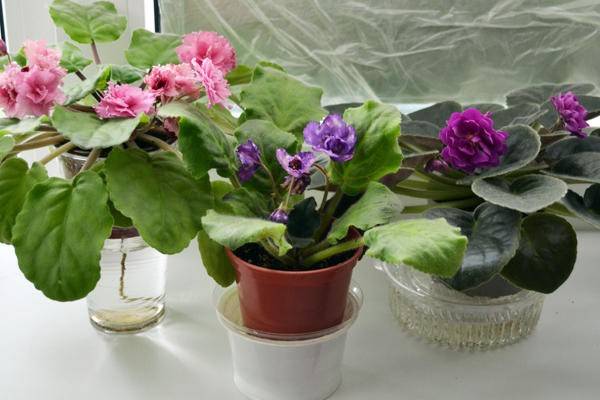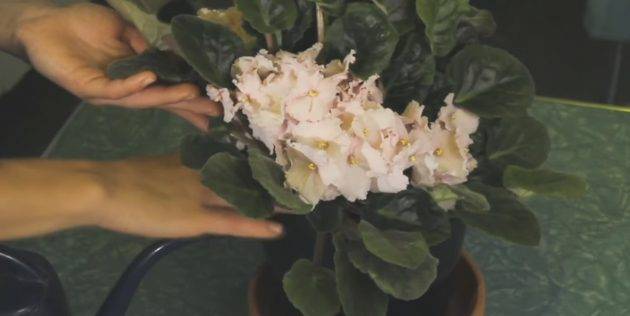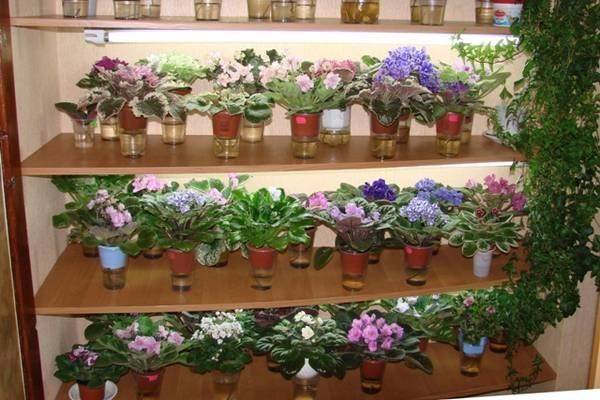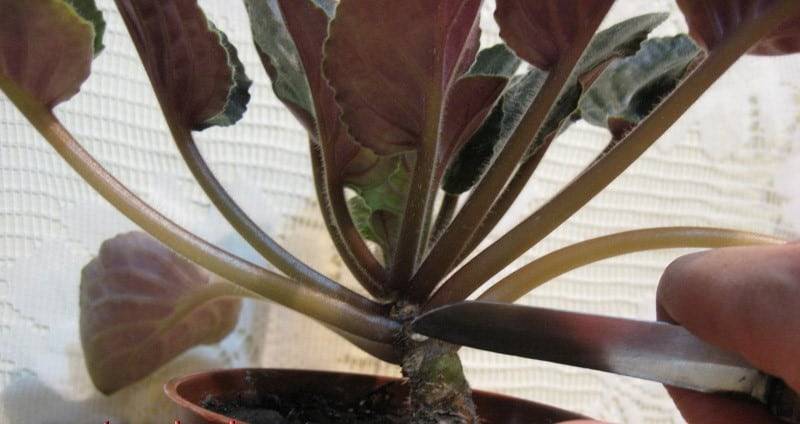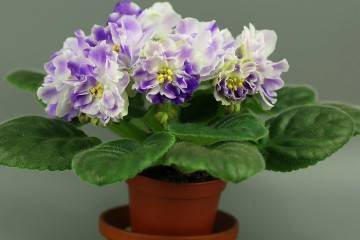How to water violets - rules and features of watering
Violets are a common flower among home growers. Although the plant is unpretentious, it needs proper care and watering. Here's how to water violets at home in a pot.
Proper watering of violets at home
Another name for the violets of Saintpaulia. In natural conditions, they grow in the mountains of Tanzania and Kenya. They can be found in crevices between stones. Therefore, when watering, it is worth remembering this, as well as about the structural features of the flower.
Features of the root system
The root system of Saintpaulias is close to the surface of the substrate, without growing deeper. Small roots of light or beige color. The flower naturally changes roots as it grows. If they become dark, this does not mean that the plant is sick.
Intensity of the procedure
Violets do not like dry periods, but they also do not tolerate waterlogging. Watering intensity depends on various factors.
Watering the plants is necessary as the topsoil dries out.
Factors that affect the intensity of water consumption:
- young flowers consume more water than adults;
- the height and width of the pot and pan directly affect the amount of liquid applied;
- different volumes of water and frequency are required in different conditions of keeping violets. This also applies to the seasons.
Negative consequences of wrong actions
Improper watering condemns the violet to improper development.
In a drought, the plant can shed all the leaves and flowers, food stops flowing, the process of photosynthesis stops.
High humidity leads to the development of fungal diseases. Violets can be affected by various types of rot, powdery mildew and late blight. Mold grows in flower containers.
Basic ways
Basic watering methods are well known and are suitable for almost all plants. But when moistening violets, you need to pay attention to some features.
Upper
A small watering can or enema is poured over the soil in a pot. The water must be settled, watering is done in a circle. They are poured exclusively into the ground, without getting on the leaves and the outlet.
In the mountainous area where violets grow, they are located near the waterfalls. The spray moistens the air, so no special watering is required. At home, everything is different: on wet leaves, water flows into the core, which leads to decay of the root system.
Through the pallet
Tray watering is the most suitable method for a home environment.
There should be holes at the bottom of the pot, which are covered with expanded clay and clay shards. Water is poured from a watering can into a tray of violets, then topped up as it enters the pot. Watering is stopped when the liquid no longer leaves. It must be drained to prevent root rot.
You can simplify the task by placing a drain in the pan, which can be moss.Water is gently poured onto it, and the moss gives moisture to the violets.
Capillary
It is carried out using a capillary mat, which is sold at the horticultural center. It is a synthetic felt, which is smooth on one side and fleecy on the other. The pile is covered with a special film that allows water to pass inside the mat, but does not allow roots to grow through it.
A pallet with walls is selected for the mat. It can be a regular flower box. An ordinary plastic wrap is laid on the bottom, then the mat, slightly going onto the side walls.
The mat is poured with water so that it does not float, but absorbs the liquid. You can check by pressing the film with your finger, it will remain wet. Then pots of Saintpaulias are placed in a box, which begin to absorb moisture from the mat.
This watering can be enough for a month.
Wick
Wick irrigation of violets is best suited for transplanting, as the method requires careful preparation.
In the pot where the violet will be planted, a wick is threaded through the drainage hole, covered with soil mixture and the plants are planted.
Instead of a pallet, place a container with water under the violet, which should be no more than two-thirds full. These can be plastic cups, cut bottles, or containers with a lid that has a hole in it. The saintpaulia root system does not touch the water, the pot hangs on the container. Only the wick comes out of it into a jar of liquid.
The wick is made from various materials, both natural and artificial. Very often, nylon tights are taken, from which strips about 2 cm wide are cut.
There is a serious drawback with wick irrigation. Together with moisture, various harmful substances rise up to the soil surface, which interferes with the development of roots.
Immersion
Often watering in this way is not used. But once every 30 days, you can pour water into a basin so that, when you put a pot there, it will be in vodka by a third. Moisture will begin to flow into the container.
When the earthen lump is well saturated, the plant is removed and returned to the growing site.
Seasonal watering
Saintpaulia is an evergreen plant, but its development is influenced by the seasons of the year.
In winter
The winter period in plants is a dormant period, and the uzambar violet is no exception. Although sometimes its flowering continues in winter. During rest, watering is reduced, and fertilizers that were added to the water are completely removed.
If the plant is on the windowsill, it should be covered from drafts by placing a cardboard or other material between the window frame and the pot, since water can become very cold in severe frost, which will affect the flower.
If there is a battery near the violet, then the air becomes very dry. It is necessary to put a container of water next to it, spray a flower or turn on a humidifier in the room.
In summer
In summer, you need to water the flowers more often. In May-August, violets are actively developing, so you can add fertilizers to the water once every two weeks. In the driest month, watered every other day. If the flowers are taken out to the balcony, then they monitor the weather changes. In heavy rain, the violets are covered with polyethylene.
Water characteristics
To make the violets feel good, it is necessary to water the flowers with water, which has been settled for several days. If possible, melt or rain is used.
Temperature
The water temperature should be at least room temperature to prevent the occurrence of various diseases.
Acidity
The soil for indoor Saintpaulias is taken neutral, but in order to remove an excess of salts that enter the pot after watering, it is sometimes acidified by adding a small amount of food acid: malic, citric, acetic. Such feeding is carried out no more than once every 30 days.
Rigidity
The hardness of the water is reduced. One way is freezing. A container with water is placed in the refrigerator for several hours. This will help soften the solution. Then they must defrost it and wait until it heats up to about 20 ° C.
Can I use boiled or tap
You can get high-quality water for irrigation by boiling the liquid. You cannot pour hot water into the flowers, you need to cool it.
Water flows from the tap, which is disinfected using various trace elements: chlorine, fluorine, calcium, etc. Such a variety of salts leads to the death of violets. It is possible to use water flowing from the tap only in rare cases.
How to water at different stages of development, transplant, rejuvenation
Different amounts of water are used at different periods of the life of Saintpaulia.
| Period | Watering features |
| Young violets | They especially need watering, as they get nutrients from water. |
| Adult violets | Reducing the amount of water. |
| When transplanting | Depends on the method: if transshipment was carried out, then watering can be postponed for a week, if the soil was replaced, then it is watered immediately. |
| During breeding | If propagation is carried out with a leaf, then you can spray the violets, and place the container in a bag, if with a cuttings, then moisten the substrate. |
Experienced flower growers, when asked whether it is possible to spray violets with water, unequivocally answer - yes, but only in very dry periods, creating a kind of spray of waterfalls, near which Saintpaulias grow.
Violets feel great on windowsills in the office and at home. It is necessary to provide them with good care and watering, then they will delight their owners with flowering for a long time.
